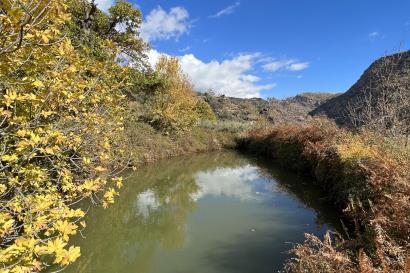
Of the many things I love about Spain, having to fork over euros for a glass of water at restaurants is not one of them. The Iberian Peninsula’s relationship with water is complicated: though surrounded by ocean, Spain is home to some of Europe’s driest regions and regularly suffers from water stress due to recurring droughts. Back on the East Coast—where a raincoat and umbrella are autumn necessities—water availability isn’t something I often think about. Here, though, water plays a curious role in the culture, history, and politics of the Iberian Peninsula—and studying this role, I think, sheds some interesting light on the relationship contemporary Spain shares with its environment.
To understand modern water management in Spain, it is useful to first discuss its historical context. The cultural importance of water in al-Andalus (the name for Muslim-ruled territories in the peninsula prior to 1492) was paramount: in Granada, you’ll find evidence of old aljibes (Arab cisterns), fuentes (fountains), and albercas (water pools) scattered throughout the city’s architecture. The prevalence of water in Granada’s architecture is explained, in part, by its political and religious significance in Muslim society: water was used as a symbol of political power due to its scarcity, while cleansing oneself before prayer (Wudu) is a core Muslim practice.
This cultural reverence for water in al-Andalus can be understood within a context of societal respect for the environment. In my Mediterranean Ecosystems class, we have spent a considerable amount of time discussing the concept of symbiosis, which characterizes a mutually beneficial relationship between two species. This interdependence creates a shared incentive for mutual prosperity, and this is exactly how the relationship between the environment and al-Andalus can be characterized: human societies protected and nurtured the environment which, in return, provided valuable resources to human society.
When our class visited the mountain region of La Alpujarra, this symbiosis between al-Andalusi society and its environment was most evident in the system of Arab acequias (aqueducts) that stretch across the Sierra Nevada. Unlike Roman systems, the acequias were built to minimize the impact on the natural landscape by 1) utilizing the force of gravity to move water and 2) being constructed of materials found in the immediate landscape. More importantly, the system of acequias enhanced the environment by irrigating the regions through which they ran. Additionally, these acequias filtered into sitting pools, or albercas, which provided local fauna with a source of water. By utilizing this minimally invasive and ecologically beneficial method of water management, the Arab societies of La Alpujarra diverted resources from their environment for their own use while also preserving and enhancing the ecosystem (and, thus, ensuring further collection of resources).
Today, water management in Spain looks a lot different: the ancient watershed of La Janda, for instance, has been drained to create land for intensive agriculture. These same macrofarms have also recently come under fire for illegal water well drilling, which lowers already-depleted water tables. While economically beneficial in the short run, modern water management in Spain lacks the same mutualistic vision that characterized the relationship between humans and water (and the environment) in al-Andalus. Whereas the philosophy was once “when the ecosystem prospers, so too do human societies,” today’s approach to water management might be characterized by the pursuit of economic well-being regardless of the long-term ecological consequences.
While a strong economy is indeed important—sustainability, after all, encompasses not only environmental issues, but also economic and social ones—it is interesting to think about how water management systems can be designed such that human economies and environmental preservation share common incentives, as they did in al-Andalus. While the system of acequias might be millennia old, the idea that human society and its environment can share a mutualistic relationship doesn’t have to be.

Caroline Hallmark
Hola! My name is Caroline (she/her), and I am a rising junior at Bowdoin College studying History and Economics with a minor in Mathematics. Beyond the classroom, I’m a Wordle enthusiast and love spending time outside (though I am a notoriously slow walker). Another fact about me--I love the em-dash. Looking forward to sharing a sliver of my life here in Granada!







